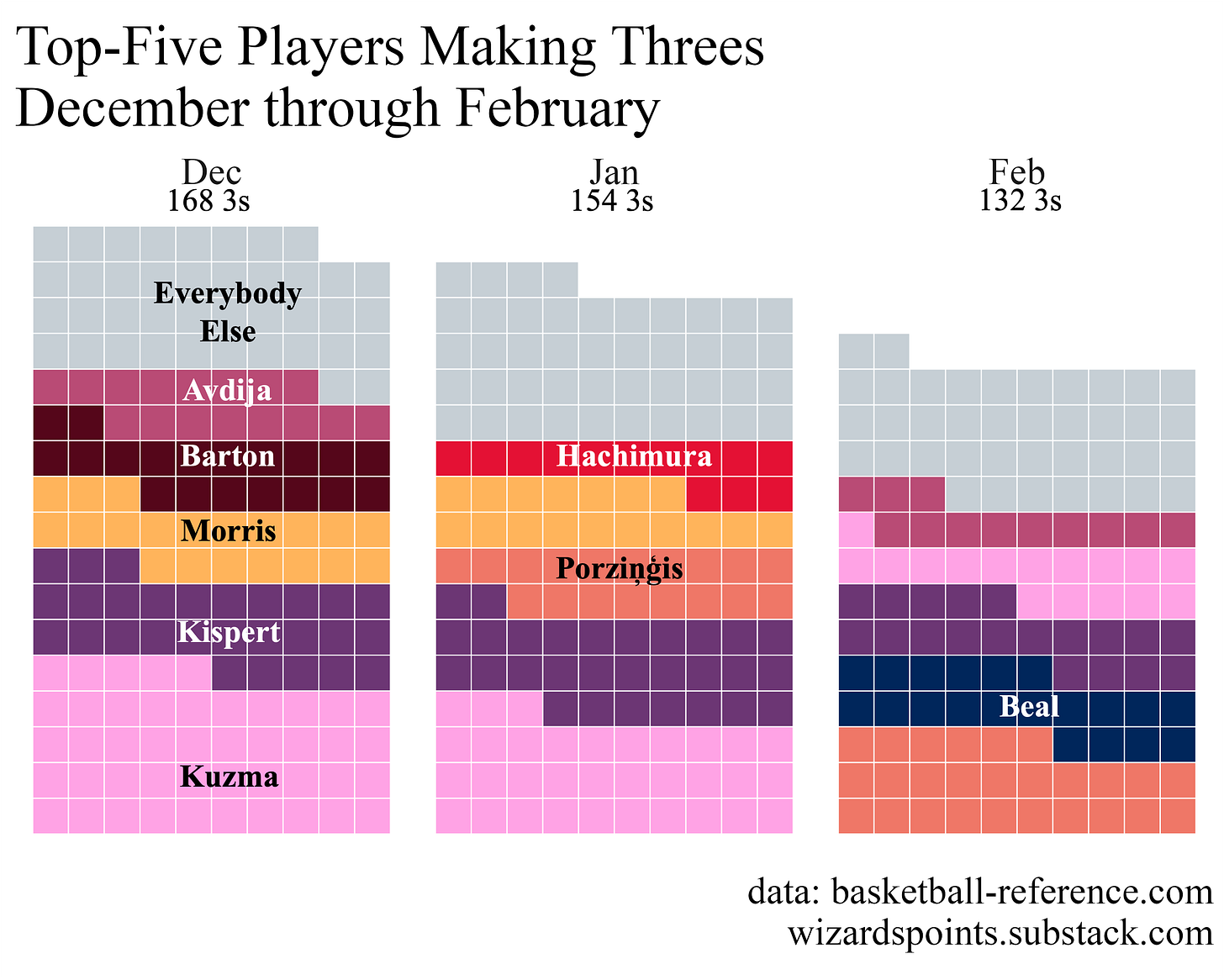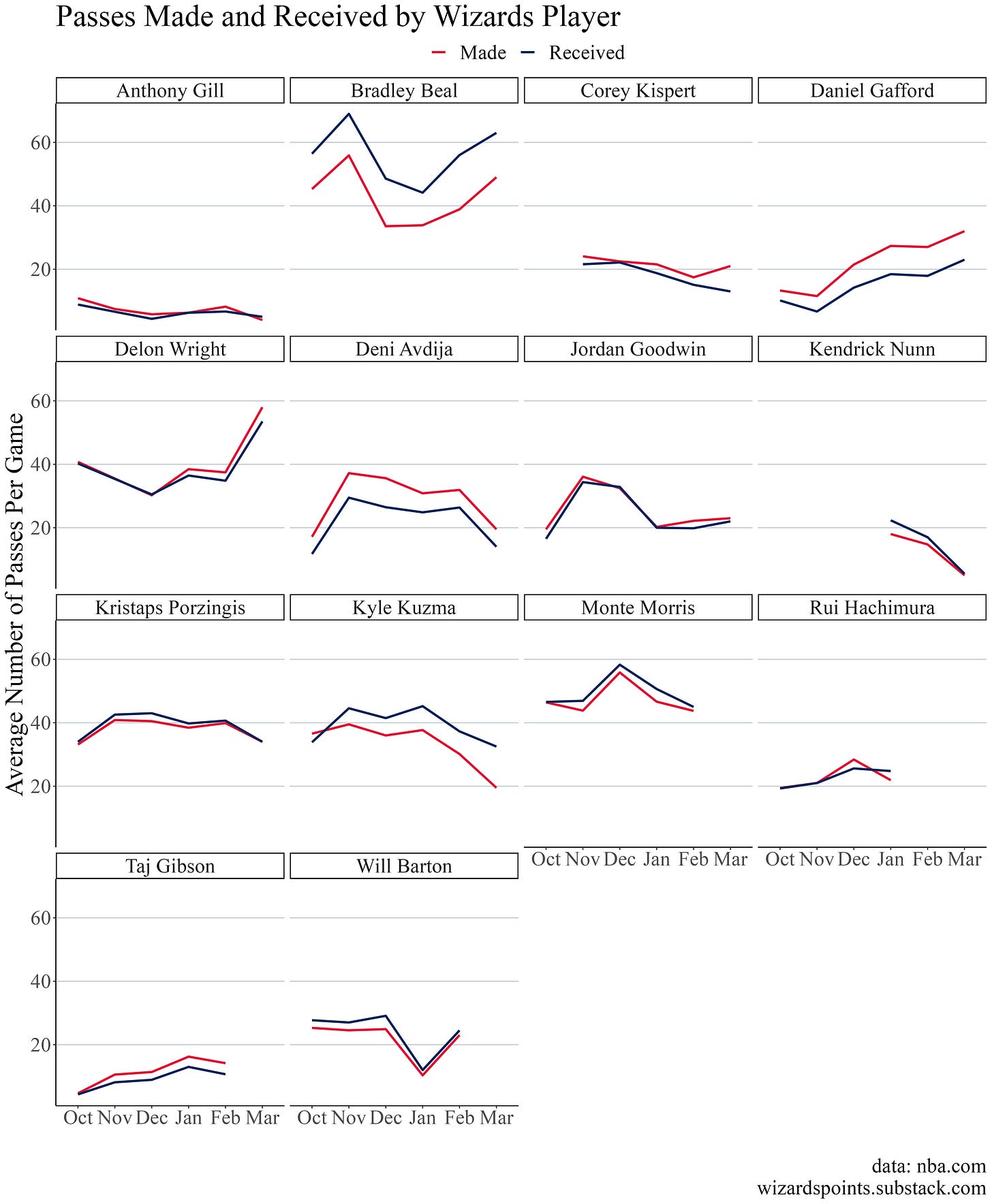Are the Wizards Getting Better?
Yes! But you should keep reading because progress is lumpy
The problem with history is you never quite know where you are in it. People talk about things like The Renaissance or World War II or the Enter the Wu-Tang (36 Chambers) like they just happened in a straight line. The 2022-23 Wizards season is a discrete point in time, but there is a shift in the team’s play that started right around the new year. The Wizards three point shooting has started to trend upward from league worst for much of the first few months to above average. The team is still inconsistent quarter-to-quarter, but the floor of the inconsistency is higher now. This means that one rough stretch before any given game’s halftime is less debilitating than back in November. Will people look back 70 years from now and remember this season like we do World War II? Probably not because they’ll be too busy fighting the climate wars. Still, with only a few months left of the regular season, it’s worth looking at the quiet progress being made and note how much farther there is to go.
So where are we?
If you listen to any part of the Wizards broadcast, Coach Wes Unseld Jr., Manager Tommy Sheppard talk about the team’s record, they’ll mention injuries. The implication is that if only Delon Wright hadn’t been injured in the first few weeks of play or Beal were a different player, the Wizards would be at the top of the East. If Beal were a different player things would be different, but every team deals with injuries. That said, it is true that as the team has gradually gotten healthy and played more games together, their play has improved.1
Since the start of 2023, the team has gradually been at or above league average from three as shown in the figure below.2 This improvement has not been as smooth as it would seem, though. Yes, the Wizards are slowly getting better from distance, but, as I’ll discuss, this is partly thanks to moving the ball better and mixing up who is actually taking (and hitting) those threes.
If you’re a fan looking for a reason to care about this team this graph speaks to their potential. The Wizards don’t have a great record maintaining talent,3 but unless things really go sideways in the off season, we should see much of the squad’s core return.
So what happened? A lot, but for the sake of making this a short newsletter, I see two related, but slightly different trends: 1. (smarter) passing and 2. less Kuzma.
Evidence of Movement
Kyle Kuzma has become the face of the Wizards. Beal has had limited availability with injuries and Porziņģis’s game is less of a model for anyone under seven feet tall. Kuzma gets downhill quickly, seems to be a good mentor and team builder in the locker room, and has made the Wizards at least moderately of interest to other NBA fans (and even non-fans) thanks to his wardrobe.4 He’s the guy you can hear in games communicating on the court and taking responsibility for failures after bad losses. He has gradually evolved in his role from a hybrid point-forward position occasionally bringing the ball up (and also just dribbling a lot) to a more traditional 3/4 forward. If we just look at the past three months where 3pt% has started to improve you can see the move away from Kuz. The figure below shows that Kuzma has taken fewer of the team’s total made threes, but also that the team has become more efficient in taking fewer, but better, shots.
During the trade deadline frenzy, I heard a few podcasts where Kuzma’s inefficiency and poor advanced stats numbers were mentioned. This is the sort of thing people say when they are largely relying on his numbers, but not their eyeballs. Does Kuzma occasionally5 toss the ball up with 15 seconds on the shot clock for a contested shot while his teammates are open? Yes. But find me a player who doesn’t do this and is also on the Wizards and can also hit big shots at the right time. The clutch shots and the silky finger rolls might come with more efficiency on a team with a different supporting cast. But Kuz wouldn’t have the same role on that team. What gives me hope about the figure above is that in January and February Kuzma’s percentage of Wizards threes started to fall from nearly a third in December to only 12.1% of total made threes in February. This means the team is getting away from living and dying by Kuzma’s hot hand. The fact that February was a short month and Kuzma sat for several games also helped push the ball to more players from distance.
Despite the shorter month and decreased play, the proportions of threes made between the first and second players responsible for the most made threes in February (Porziņģis and Beal) is much smaller than the gap between the first and second players in December (Kuzma and Kispert) at 4 percentage points to 10 percentage points. This suggests that more guys are getting looks. And that perhaps, just maybe, they are moving the ball better.
This all relates to a second slight change in the team’s play: passing. Using NBA tracking data we can compare the average number of passes each player makes and receives. While assists are a little different than passes, I find assists to be a bit unsatisfying as a stat.6 Assists and passing are correlated, but the relationship for the Wizards has varied over time this season. Instead, what I care about for understanding the shift in the team's performance is simply ball movement. The "everybody" of everybody eats.
What is notable in this figure is that the rate at which Beal is receiving passes is increasing faster than he gives them out, Kispert is making more passes, and Kuzma is making fewer passes. I see each of these as good things.
Beal has shown he is still a great scorer. His shooting got him the contract. The less he dribbles and tries to set up plays, the fewer grey hairs I get. From January to February, Beal increased the number of passes he made by five passes per game on average. Over this same period, the number of passes he received increased by nearly 12 per game on average.
Kispert making more passes also suggests his game is maturing. While J Crew Jesus currently has the 10th best 3pt% in the NBA, he can be streaky, especially if you look at his home vs. away numbers. He has proven himself to be a great off ball cutter, but finding the guy who finds the guy who finds the guy who can score is a talent that shows his understanding of the game is improving. While he has generally averaged between 1 and 3 more passes made than received so far this season, he is on pace to nearly double this rate.
Finally, Kuzma making fewer passes is the result of a few factors—adjustments to the line-up and the point guard rotations and the schedule come to mind—but to me the key implication is that he doesn’t necessarily need to be the guy making passes, or receiving them, for the team to hit threes.
What is Happiness?
It doesn’t always feel like it when they are blowing 20 point leads, but the Wizards in March are giving fans something to look forward to. There are five teams all within five games of each other in the East and the actual order of places 7 through 11 seems pretty arbitrary. It’s easy to imagine that we could be in 8th tonight or in 11th and then back again by next week.
Critics will complain that it’s not clear what the Wizards are. But I say, it’s not clear what the Wizards are! They seem to be improving in fits and starts. And like Tracy Morgan explains (apologies for the cheesy background music), happiness is having something to look forward to.
We can look forward to a few more months of upsets and clutch shots. A few more months of changing and evolving roles. And if we’re lucky, a few more months of Kuz-has-done-it-again fit pics. It’s not clear if this is the beginning of a new Wizards era, the end, or what will be a passing reference in the “After [enter number of years], the Wizards have won a championship” articles of the future. There is still a lot of basketball to look forward to this season, though. That’s something fans should be happy about.
It’s also true that their schedule is a bit easier. At the same time, they have nearly lost games that should have been huge wins (e.g., Houston) and blown leads or gotten blown out (e.g., Bulls) during this healthy time.
This figure showing the team as having one of the least consistent season-to-season rosters haunts me every time I start to look at jerseys.
He’s also top 20 in field goals missed and turnovers per basketball-reference.com.
Ok, maybe more than occasionally, but less than semi-regularly. So, whatever is more than occasional but less than semi-regularly, that’s the amount he does this. His efficiency stats are not great, but my stance is that the Wizards overall are not super efficient and Kuzma brings a lot that other players don’t in his leadership and experience.
For more on this, see Seth Pratnow’s The Midrange Theory, which details all of the ways assists are a confusing stat. It ultimately comes down to the fact that you don’t get an assist unless the guy you pass to scores, which isn’t really what we think of when we think about ball movement. There is also the stat of assist-to-turnover ratio, which has its own issues, and doesn’t get the idea of everybody eating.




